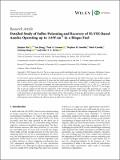Detailed study of sulfur poisoning and recovery of Ni-YSZ-based anodes operating up to 1.8 W cm-2 in a biogas fuel
Abstract
Ni-YSZ (nickel-yttrium-stabilized zirconia) is a common anode for solid oxide fuel cells (SOFCs) because of its excellent catalytic performance and electronic conductivity. It shows that the nickel anode-supported cell exhibits good cell performance in a biogas fuel of 36CH4-36CO2-20H2O-4H2-4CO. Unfortunately, natural biogas fuels often contain sulfur, so using nickel anodes is not always straightforward. This paper investigates the sulfur poisoning and the recovery of BaCe0.7Zr0.1Y0.1Yb0.1O3-δ- (BCZYYb-) (Ce, Y, and Yb codoped barium zirconate) impregnated nickel anode-supported cells operating up to 1.8 W cm-2 in the biogas. The in situ gas analysis reveals that the suppression of the reforming reactions might cause sulfur poisoning in a 4 ppm (v) H2S (hydrogen sulfide) in open circuit conditions, whereas the current degradation in working conditions could be attributed to the deactivation of reforming reactions and catalyst activity. The incidence of water-gas shift reactions is associated with the degradation rate of these two reactions. After removing the H2S, the recovery is accelerated by a steam hydrogen fuel, indicating that steam facilitates the efficient release of sulfur from nickel sites.
Citation
Ma , J , Jiang , Y , Connor , P A , Gamble , S R , Cassidy , M , Jiang , C & Irvine , J T S 2023 , ' Detailed study of sulfur poisoning and recovery of Ni-YSZ-based anodes operating up to 1.8 W cm -2 in a biogas fuel ' , International Journal of Energy Research , vol. 2023 , 2339117 . https://doi.org/10.1155/2023/2339117
Publication
International Journal of Energy Research
Status
Peer reviewed
ISSN
0363-907XType
Journal article
Description
Funding: This research is supported by the EPSRC-DST India-UK project EPI037016/1. This work is also partially supported by the Sichuan Science and Technology Program (under agreement nos. 2021YFH0222 and 2019YFH0177). The authors acknowledge the Zigong Science and Technology Program (under agreement nos. 2020YGJC18 and 2019YYJC24).Collections
Items in the St Andrews Research Repository are protected by copyright, with all rights reserved, unless otherwise indicated.

